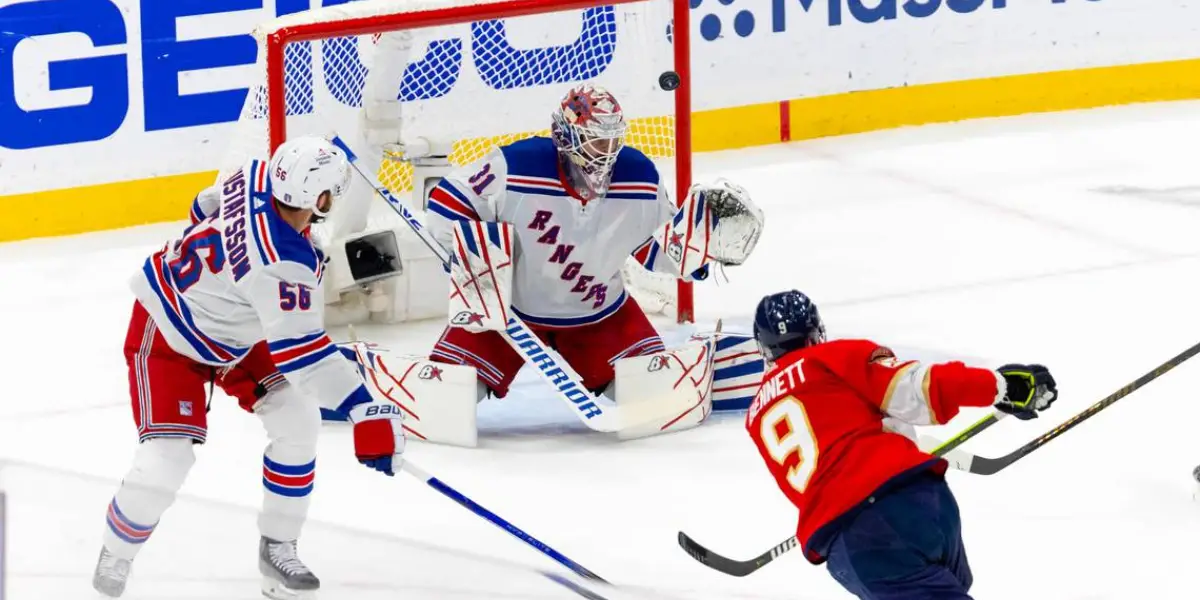
With the summer celebration in full swing for the Panthers, it’s going to be another quick turnaround for them heading into next season. It seems that most, if not all, of the free agency moves have been made by the team to fill in the gaps by the players who have departed this summer. There are plenty of returning players and some new faces coming in, so let’s take a look at how all the pieces of the roster puzzle fit together before training camp starts. This week, we will start with the top six forwards, who are all returning players.
Aleksander Barkov:
Barkov finally started to get the recognition he deserved during the playoffs with his incredible play against some of the best players in the league. The Captain of the Panthers led his team to ultimate victory after a crushing defeat in the Stanley Cup Final a year earlier. Barkov centers the top line for Florida with Reinhart on his right side and either Verhaeghe or Rodrigues on the left; Tarasenko also played on the left on the top line but has since gone to Detroit. During the regular season, Sasha played 73 games with 23 goals and 57 assists for a total of 80 points and had a +/- of +33. He had five powerplay goals, two short-handed goals, and four game-winning goals, averaging 19:38 minutes of ice time. The all-around player gets time on both parts of special teams, playing on the top units for the power play and penalty kill. Barkov led the team in faceoff win percentage at 57.3 and took the most faceoffs, 1,100, winning 630 and losing 470. He totaled the sixth most shifts out of anyone and the third most out of the forwards behind Reinhart and Luostarinen. For the playoffs, Sasha played all 24 games and had eight goals with 14 assists for 22 points. He had one powerplay goal, one short-handed goal, four game-winning goals, and averaged 21:14 minutes of ice time. His strong presence in the faceoff circle continued with a 55.2 FO%, taking 413 total faceoffs, winning 228 and losing 185. Barkov took the third most shifts out of anyone during the playoffs and had the most shifts out of the forwards at 689. Barkov’s incredible stick handling and puck management are some of his best qualities as a forward. He doesn’t always put up huge goal-scoring numbers, but he has these intangibles in his game that give him an edge over other players.
Samson Reinhart:
A breakout career year for Reinhart capped off by scoring the Stanley Cup winning goal, Sam Reinhart needs no introduction. He was an absolute terror for other teams on the power play this season, set a franchise record for goals scored in a single year (regular season and postseason), and became part of one of the deadliest duos in hockey with Barkov. Reinhart played all 82 games of the regular season, scoring 57 goals with 37 assists for a team-leading 94 points, and he was +/- +29. He led the NHL in powerplay goals at 27 and short-handed goals at 5, and he had 11 game-winning goals; he averaged 20:17 minutes of ice time. Reinhart, like Barkov, is an all-around player who does everything for the team and also plays on both top units for special teams. Prior to teams absolutely hounding him during power plays, Reinhart went on a stretch of about two months where scoring on the man advantage was near automatic with him living in the slot position. Reinhart struggled in the faceoff dot during the regular season only sitting at a FO% of 44.2, he took 530 total faceoffs winning 234 and losing 296. Sam took the third most shifts out of anyone and the most shifts out of all forwards, with 2017. For the playoffs, Reino played all 24 games and had ten goals and six assists for a total of 16 points. He also had four powerplay goals, one short-handed goal, two game-winning goals, and averaged 21:37 minutes of ice time. Reinhart improved a bit in the faceoff circle, getting up to a FO% of 46, winning 84 and losing 95 faceoffs. For as strong of a player as he is, faceoffs are probably the weakest part of his game; however, he’s not a high-load-bearing faceoff player. Reinhart took the sixth most shifts out of anybody and the second most out of the forwards at 677. Don’t let his high-scoring ability fool you, he’s a strong defensive player too and isn’t afraid to play hard and heavy with hits and forechecking. Reinhart will have a lot of eyes on him next season after the huge uptick in scoring this year, do I think he’ll hit nearly 60 goals again next season? Probably not, but I do think he’ll live in the 40-50 range, as teams will be scouting hard for him on the power play.
Evan Rodrigues:
Rodrigues was such a pleasant surprise during the Stanley Cup Final. He’s a player who can ride under the radar and then burn you when you’re paying more attention to players like Reinhart, Verhaeghe, or Tkachuk. Evan played up and down the lineup last year but spent most of his time either on the top line with Barkov and Reinhart or on the third line with Luostainen and Lundell. For the regular season, Rodrigues played 80 games and had 12 goals with 27 assists for a total of 39 points and a +/- of +26. He also had three powerplay goals and one game-winning goal and averaged 15:10 minutes of ice time. Evan saw time on the second powerplay unit and doesn’t kill penalties right now. Like Reinhart, Rodrigues doesn’t spend much time in the faceoff dot, but he had a FO% of 50, winning 29 and losing 29 faceoffs. Of the regular players in the lineup he took the least total amount of faceoffs, he had the 12th most shifts of out everyone and the sixth most shifts out of the forwards at 1577. Rodrigues had a strong playoff where he scored seven goals with eight assists for 15 total points in 24 games. He also had two powerplay goals and averaged 14:42 minutes of ice time. Most impressively, seven of his 15 points came in the Stanley Cup Final, where he scored three goals in two games. Evan was tasked with taking more faceoffs during the playoffs when Sam Bennett got hit in the hand with a puck and was unable to take faceoffs upon his return to the lineup. Rodrigues stepped up to the challenge and was great for the Panthers with a FO% of 55.1, winning 54 and losing 44. He took the third least amount of shifts among players who played every game, with 533, just above Tarasenko and Stenlund. Part of the shift differential is that he plays on the less-used powerplay 2 unit and doesn’t kill penalties, so with the amount of special teams play that Florida saw, it’s not that surprising to see such a gap. Rodrigues doesn’t put up the most points on the team, but he’s an effective player when he gets the chance to play with the top line and also a great addition on the third line, which has a talent for killing time off the clock by getting into long board battles. Rodrigues is a versatile player who allows for more flexibility in the Panthers’ lineup and has been able to build good team chemistry among the top three lines.
Sam Bennett:
Bennett has a reputation for playing at a different level during the playoffs, and had he not been injured and missed games this season, he would’ve likely been near a point-per-game player for Florida. With that said, he also has a reputation for playing hard and hitting even harder, especially during the postseason. Sam played 69 games for the regular season with 20 goals and 21 assists for 41 total points and +/- of +17. He had five powerplay goals and two game-winning goals and averaged 16:36 minutes of ice time. Sam is part of the second powerplay unit and doesn’t kill penalties for the Cats. Of the three returning centers for Florida, Bennett is weakest in the faceoff circle with a FO% of 45.5, winning 390 and losing 468 faceoffs. As a whole, the Panthers’ second line isn’t particularly strong with faceoffs, with Tkachuk and Verhaeghe taking very few faceoffs and having lower win percentages. Sam took the 13th most shifts for Florida and the seventh most out of the forwards at 1515, he also didn’t play every regular season game and doesn’t kill penalties so that explains the differential. As for the playoffs, Bennett played 19 games with seven goals and seven assists for 14 total points. He had one powerplay goal and one game-winning goal and averaged 16:03 minutes of ice time. While Bennett wasn’t the best for faceoffs during the regular season, the postseason is a whole different story. Once he started taking faceoffs again, he was at an FO% of 51.4, winning 54 and losing 51 faceoffs. Even with missing five games, Bennett still logged 451 shifts for the playoffs. Sam is a strong, physical player who’s not afraid to throw a big hit on someone. His style of play certainly riled up Bruins fans after the whole Marchand incident and the goal he scored in Boston. Bennett’s a hard player to play against, and his style is more suited for the playoffs than the regular season, where the intensity is higher.
Matthew Tkachuk:
The Panthers’ Assistant Captain was battling back from a broken sternum during the regular season, and it took him a while to find his grove again. But the back half of the season saw Tkachuk become one of the highest points producers in the entire NHL, and had he not been so severely injured, he likely would’ve hit the 100+ points mark once again. As it stands, he played 80 games for the regular season with 26 goals and a team-leading 62 assists for 88 points, the second most on the team; he was +/- +19. Tkachuk had six powerplay goals, one short-handed goal, and two game-winning goals with an average ice time of 18:38 minutes. Tkachuk was fantastic on the top powerplay unit this season being one of the primary passers to get the puck to Reinhart, he likes to live down near the goal line bumper position for the quick pass to the slot. He doesn’t kill penalties for Florida nine times out of ten but on a few occasions, he was called in for the PK and scored his first short-handed goal as a result. It’s unlikely we’ll see Tkachuk regularly kill penalties for the Panthers but it’s nice to know he wouldn’t be a huge liability if it’s necessary to put him out there for it. Matthew isn’t a faceoff player for Florida either so if there’s one aspect of his game that could improve it’s that. Tkachuk took the eighth most shifts out of anyone and the fourth most out of the forwards at 1749. This year, Tkachuk didn’t have to carry the load for the playoffs. In 24 games, he had six goals with 16 assists for 22 points to tie Barkov for the most points on the team. He had no special teams goals but he did have two game-winning goals and averaged 18:29 minutes of ice time. Tkachuk had the seventh most shifts out of all players and the third most out of the forwards with 593 shifts, he was only behind Barkov and Reinhart for the forwards. Matthew has quite the knack for annoying opponents and drawing penalties, he led the NHL in drawn penalties last season and was voted the player that opponents hate playing against the most but would want on their team by other players in the league. A true locker room player, he shows great appreciation for the franchise as a whole and is quick to give credit to the people who work behind the scenes for the things that they do. His impact on the Panthers team can’t be overstated as the success the team has seen since he joined is very visible, back-to-back Eastern Conference Champions, back-to-back Stanley Cup Finals, and one Stanley Cup Win. He willed his team to the Stanley Cup Final during the 2023 playoffs, leading the team in goals, assists, points, +/-, and even penalty minutes. Tkachuk’s leadership, along with Barkov’s, has transformed the team into a Championship Winning Team and changed the culture as well, making Florida a place where players want to come and play.
Carter Verhaeghe:
Few players thrive the way Carter Verhaeghe does during high-pressure situations. Nicknamed Swaggy or Mr. Clutch by his teammates Verhaeghe has an incredible ability to come through when the team needs him most, just look at Game 7 of the Stanley Cup Final. His fantastic redirection on the puck gave Florida the 1-0 lead and all the momentum they would need to win. He played 76 regular season games and scored 34 goals with 38 assists for 72 points, that goal total could have been higher but Barkov got into a habit of tipping in Verhaeghe’s shots during the second half of the season. He was +/- +17, had eight powerplay goals, and seven game-winning goals while averaging 17:57 minutes of ice time. Carter also isn’t a big faceoff player, but he had a FO% of 44, winning 37 and losing 47 faceoffs during the regular season. Moving into the playoffs, Verhaeghe played all 24 games, scoring 11 goals with 10 assists for 22 total points. He had four powerplay goals and three game-winning goals and averaged 19:20 minutes of ice time. Like Tkachuk, faceoffs are where the biggest room for improvement is in his game. He had an FO% of 34, winning 15 and losing 29. Verhaeghe holds plenty of franchise records for the playoffs including goals and game-winning goals. He also holds the team’s highest G/60 in all situations at 1.337 and leads the franchise in even-strength assists at 25. Verhaeghe spent time on both the top line and the second line this season. Both lines are dangerous for scoring but especially so when he plays on the top line with Barkov and Reinhart. He’s the leading goal scorer on the second line and has a dangerous shot from the circle on the top powerplay unit. He’s great in net-front situations and reads the game at a high level. Verhaeghe has the ability to quietly creep into high-danger places when teams are more focused on Reinhart or Barkov, especially on the power play where Reinhart can have as many as all four penalty killers on him. That opens up Verhaeghe to score, and he has the patience to out-wait goalies to get a shot off. A perfect example of that was his overtime game-winner in Game 2 against Tampa Bay. Carter’s made a name for himself as a playoff performer and lives for the high-intensity parts of games, the closer to a playoff game a regular season game feels the better he plays.
Up next week: Third Line Forwards, Returning Fourth Line Forwards, and Newcomers.
Discover more from Inside The Rink
Subscribe to get the latest posts sent to your email.



